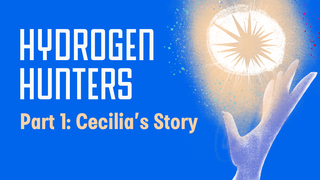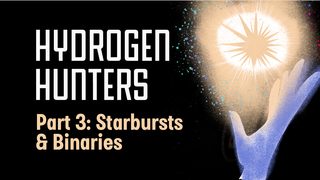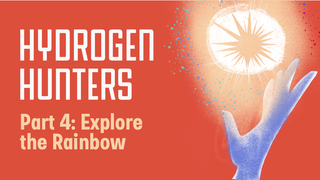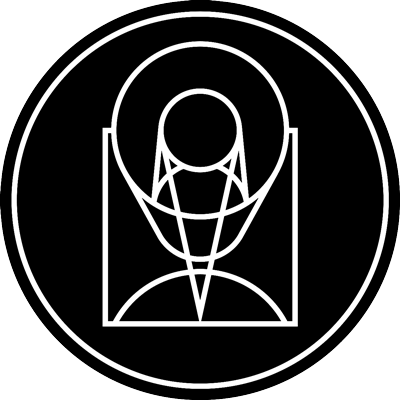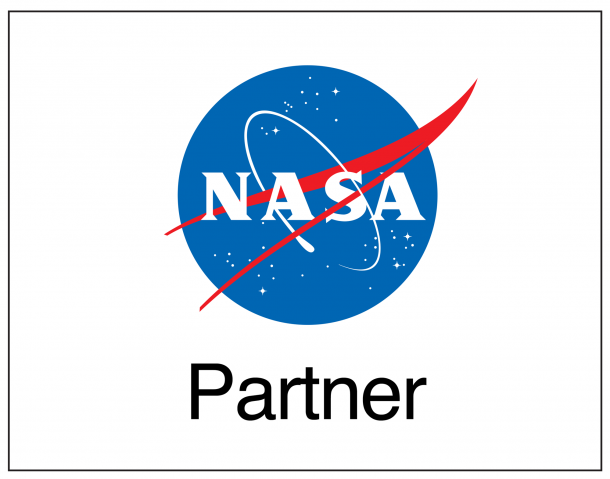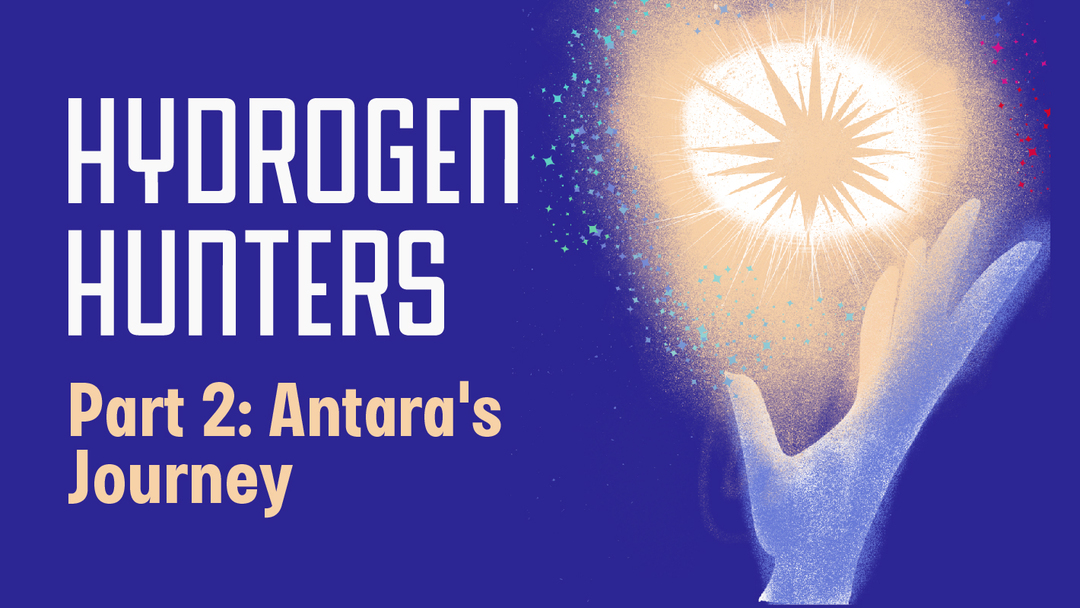
Download Episode (20.5 MB) Download Low Music/Distraction Episode (20.5 MB)
Feedback for Hydrogen Hunters Part 2: Antara's Journey
By leaving feedback, you agree to allow NASA's Universe of Learning to publish the content and information you provide in your submission form. We will only use this information to recognize your entry on our series and social media, and we will never publish your email.Transcript for Hydrogen Hunters Part 2: Antara's Journey
Hello everyone, and welcome back to NASA’s Universe of Learning’s Diaries of the Cosmos. I’m Rutuparna Das, and we’re continuing our story about Hydrogen Hunters. Last time, we followed Dr. Cecilia Payne-Gaposchkin on her journey through science and spectroscopy, and on her discovery that stars are made up mostly of hydrogen and helium.
Today, we’re chatting with astrophysicist Dr. Antara Basu-Zych, a NASA scientist who is currently studying stars and galaxies using hydrogen spectral lines. Dr. Basu-Zych received her Bachelor of Arts in Astronomy from the University of California, Berkeley, and then got her PhD from Columbia University. Currently, she is a research faculty at the University of Maryland Baltimore County’s Center for Space Sciences and Technology, and is a research scientist for NASA’s Goddard Space Flight Center, High Energy Astrophysics Science Archive Research Center, and X-ray astrophysics laboratory. Her research is in X-ray binaries and starburst galaxies, which we will be hearing more about today and in Part 3!
Talking to Antara is Elizabeth Gutierrez. Elizabeth earned her bachelor's degree in physics and astronomy from The University of Texas at Austin. As an intern with the Smithsonian American Women’s History Initiative’s “Because of Her Story” program, Elizabeth researched and developed our cosmic story for today. I’ll now hand it over to her to interview our expert!
~*~
Elizabeth: Thanks Rutu! Hello everyone! I’m Elizabeth Gutierrez. As Rutu mentioned, today we will be talking with Dr. Antara Basu-Zych. Antara, welcome – it's such a pleasure to have you here with us today!
Antara: Thank you, I'm delighted to be here.
Elizabeth: Thanks! So Antara I'm wondering how you actually first became interested in astronomy, because I feel like astronomers might have some kind of story of, you know, looking at a meteor shower for the first time like Cecilia Payne-Gaposchkin did, or visiting a local observatory or planetarium…what first sparked your interest in astronomy?
Antara: Yeah, so I have a couple of childhood memories… the first is, a family friend was an amateur astronomer, and he bought his telescope and had it set up on Saturn and was so excited that he called us all over to look at it. And I remember looking at Saturn, which was not very impressive by my eye, and looked through the telescope and was like “wow,” and it just kind of blew my mind that, you know, something that was basically just a glimmer on the sky turned into something that had moons and you could see the rings, and it was just so beautiful and it made me wonder what else is hidden out there in space… and so I think that that was the first thing that kind of sparked my imagination.
But I do have to say I have fond memories of my grandfather, um, I remind him that, do you remember we – I was probably four or five at the time and we went to a beach in Goa, and we were laying out and it was nighttime and he started telling me all the mythological stories of the constellations and the stars, and, um, I think it was my earliest connection to the night sky and just, it was fun…hearing stories like that was was a nice way to appreciate the night sky.
And then in fourth grade we did the walk of the planets, which is the scale solar system exercise where the Sun is the size of a beach ball. And it was elementary school and it got to the edge of the field, and the teacher said, “Okay so this is where Jupiter is,” and said, “You know, that's all we can walk, but then you see that stop sign over there? That's Saturn,” and kept going all the way out. And, you know, back when I was in elementary school, Pluto was a planet, and Pluto was in the nearest shopping center, which I had never even considered walking to because it was sort of beyond what I thought my fourth grade eight-year-old legs could go. So, I realized that space was so big, and so again it was that same being hit by the same information of, “Wow there's a lot out there, and I just wonder what things we can't even see.”
So, I think the more I learned about astronomy on my own and, you know, learned in school or from friends or whatever, I was more and more fascinated by, um, the extremes of astronomy. So like, things are so big and you have the biggest scales, and then later on I learned about physics and, you know, these smallest subatomic particles make up sort of what happens at the center of the Sun. And then you have the hottest and you have the coldest environments in space, and the densest which is, you know, black holes, and that whole topic blew my mind. So I think I kept on finding out more and more about astronomy and it was just – it stretched my imagination beyond what I was used to, and that was really something that I loved.
Elizabeth: It sounds like you had a lot of experiences growing up that really just led your curiosity to many places, especially wondering about what is there in the universe. I'm wondering, after grade school, what led you to continue this path to where you are today, working for NASA and these other great institutions.
Antara: Yes, so, while I was fascinated from this young age, I didn't really know that you could be an astronomer or astrophysicist or do this as a life career. So, when I came to thinking about careers, I was kind of like, “Well, I guess I could be a doctor, or a lawyer, or –” I don't know, nothing really kind of caught my fancy. I just kept coming back to, “Well, I think astronomy is really cool.” And so this was about 10th grade, I was taking the PSATs, and I noticed that under the listings of careers, “astrophysicists” was on that list. And I was like, “Oh, I didn't know this was a career!” So I marked the box, and then that meant that for the next few months I started getting materials in the mail about astronomy programs and physics programs, and kind of learning more about it.
And it turned out that, for my high school, we had a graduation requirement of doing some sort of a – an “experience” it was called – and it could be anything, like learning to play the piano, but I took the opportunity to job-shadow somebody. And I was very lucky because my father worked at Lawrence Livermore Laboratory in California, and there's an astronomy department there, and so he set me up to shadow somebody there for a full day. So this was actually where I learned what modern astronomers do, that, you know, they're not just looking through telescopes and kind of looking at things and making qualitative assessments, that they actually take data on these CCD detectors – and this is actually where I learned what spectroscopy was. And so, it was a great experience, a great learning experience. I also learned what career astronomers do, and so that was the first sort of realization that, I could do this, I could do this as a career, and that seemed like the best fit for me.
So when I went to college, I did actually continue doing some research at Lawrence Livermore because, you know, my job shadowing experience gave me kind of a good connection to that, and I was able to set up some research through Lawrence Livermore. I went to UC Berkeley, and by the time I finished college, I had to say I was a little burnt out. I didn't see a lot of role models who in my opinion were balancing work and life the way I wanted for myself, and so I decided maybe this is not what I want to do as a career. But, I still didn't know what I wanted to do, so I spent one year in industry at a telecommunications company, and they had satellites, and so I worked on commanding and then working some mission control for their satellites – and that sounds really exciting, but it didn't feel like a right fit for me. I was actually a little bored. And so I switched, and I tried another year of doing something different, which was teaching astronomy in a science museum in Oakland, California, which is the Chabot Space and Science Center, and that was actually a great experience for me. I loved teaching.
But what I felt was, I was missing learning for myself. Like you mentioned, I had a lot of curiosity about astronomy topics and I really wanted to kind of explore them on my own, you know, especially the unanswered questions. And so for me at that point, I was like, I don't know if this is what I want to do for a career, but grad school seems like the right logical move. And so I was more open-minded – it didn't have to lead to a career, but this is the right step for me next, because I wanted to explore my questions of interest. And so I went to grad school at Columbia, and that was a great experience. And from there I got a postdoctoral fellowship at NASA, um, which was right after grad school. That was at Goddard Space Flight Center and, you know, things kind of fell into place and it led to my current position as a research astrophysicist and staff scientist in the High Energy and Research Archive Center. So I think I had a path, but I took some alternative routes, and I also took some time to kind of decide if the next step was the right one, and I took it in baby steps. I think that was for me something that was not, uh, told that this is a good idea, you know, there's definitely a path that people say that you should take if you want to do this for a career. And that was fine, but for me, I needed to take it a little slower and, you know, analyze each step along the way.
Elizabeth: So you mentioned you took an alternative path to getting to where you are today. Could you speak more on how you had no role models and you were feeling burnt out – can you explain what that felt like, especially, I think you were in a very important stage in your career where you weren't sure what you really wanted, and taking some time off seemed to really help you figure that out?
Antara: Yeah, absolutely. So, well, I was at UC Berkeley and there were no female faculty at the time that I was there. I think that, you know, situation's better now, but at the time there was none, zero. And of the male faculty that were there, I mean, I had labs that went until, you know, past midnight and, um, a lot of the faculty were still there. And I was kind of thinking, “Huh, don't these people have families and other things going on?” and, you know, my own professors would sometimes say, “Oh, I have to, you know, I'm going to teach this class that goes until midnight, and then I'm going to jump on a plane and go travel to like Europe, and then I have a conference there, but I'll be back on Tuesday and I'll be back to teaching.” And I'm thinking, you know, I felt burned out as a student doing this for four years, and it wasn't, you know, anywhere near… I think it was like I couldn't see the horizon, I couldn't see the end of working really really hard. And I was working really hard as an undergraduate, but to think that, you know, this is sort of the level of intensity that you have to keep at all times – it was a little bit overwhelming for me. And, um, I wondered about if they have families, and what that looks like. And so, I know anecdotally that some of them did have families, but again I heard mostly like – I hate to say it like this but – their wives were the ones who were raising their children. And so, considering that – I don't know – that was not something that I was ready to give up – you know, possibly having a family or other things going on in my life. I think I'm also, at the time, I was very much into dance and I had other hobbies that – you know, astronomy is a lot of what I was interested in, but it wasn't everything that I was interested in. I had other interests as well. And so, for me to, you know, see only people who were in it 180% in my opinion was too much.
And I think that, actually, I got to grad school and, it's a funny thing that I heard – this was a great grad school, right, Columbia's not a joke – but someone said, “Well, you know, the professors understand you're in New York City, and so you should go out and enjoy some of your time, but, you know, of course you have to work hard too.” And in fact I saw that. I saw that sometimes the chair of our department would have, um, opera tickets, and maybe he wasn't able to make it, but he would say, “Does anyone want it?” And it was sort of assumed that you play hard, you work hard, you get the most out of life – and I saw a lot more balance.
So I think that that was one of the things that made me think, okay, you know…and also by that time I think the tides were turning, and we had younger faculty who did have families. We had men, we had women join the faculty, and so I was able to see how it is that people are managing and balancing, and it is possible, and that really kind of renewed my focus. And in the meantime I had time to explore things that, you know, were using astronomy but not doing it full-time and definitely not in research, and it didn't fulfill me. So I kind of, you know, tested out paths that to me led to a dead end, so I became a lot more motivated that this was what I wanted to do.
Elizabeth: So it sounds like you had a lot that you were trying to navigate here. I was wondering if there was somebody who influenced you on your journey to sticking with this – was there somebody who was a mentor for you throughout this?
Antara: Yeah, I mean, I don't see anyone in particular, but there's a lot of people who said or did little things…I don't know if they know the difference that they made. For example, this uncle of mine who showed me Saturn, um, unfortunately he's deceased, but he, you know, he never got to see me become an astrophysicist. But I know that that would probably thrill him because, you know, he showed me Saturn and it kind of changed my life. And then there was a scientist I job-shadowed, who I see sometimes in professional circles, but I don't know if, you know, if he realizes that that experience made such a big difference.
And in terms of grad school and my current supervisor, I have strong mentors and also peers, people who I went through grad school with, and actually undergrad and my research experiences with, who I still keep in touch with. And they are there to listen, empathize, and they encourage me along the way. And I think the main thing with peers is the shared experience where you realize that, um, a lot of what you're finding is a struggle that you feel like, “Oh maybe I'm not meant to do this, this is too hard,” and you want to kind of give up, and you realize, no, other people are struggling too. Some of them, you know, say it or are able to admit it, and some of them kind of struggle silently, but everybody, you know, has doubts and we're all human. So we all have, you know, sort of what we call “imposter syndrome” – you know, “Should I be doing this? If good things are happening, is it because I deserve it, or is it just a coincidence?” or, you know, something like that, that we kind of go through together. And so for me, I think I credit a lot of it to the support network that you make along the way, and I can't think of one particular person.
Elizabeth: Antara, I remember you had said that women, you had noticed, in this field tend to take on more of the childcare, and I think that ties into a little bit about Cecilia Payne-Gaposchkin. So women in astronomy 100 years ago when she made her discovery were discriminated against – they weren't allowed to hold positions, they weren't allowed to be in the observatories with the men observing at night. And so I was wondering, as a woman in science, do you think the situation has changed since then?
Antara: Um, I mean, in terms of child rearing, I am not sure, because they still say that I think women carry, you know, something like 70% of the home-life burden. My personal experience, and my husband and I have very, I would say a very nice balance, and it's probably 50-50, but not necessarily like 50% of everything. But, you know, he does some things more and I do some things more, and so it ends up being pretty equal. And from what I’ve seen of peers and even young faculty, um, when I was going through grad school, I would say that, it's hard to tell, but it was close to parity. And so that's a good change. Um, I think also, what I was saying about what I had observed as an undergraduate, was more, the faculty were men, um, and it was their wives who were doing a lot of the childrearing and home-life things. I didn't see them necessarily, it was just sort of my impression…who knows, maybe they did a lot and then they came back to work at midnight to do their astronomy research – I don't know. But in any case, from the statistics I've heard, I know that it's not exactly even, even now.
I think in general of course there's been changes since Cecelia's time – for one thing, there's a lot more encouragement for women to go into STEM fields, and also awareness of the issues for keeping women in these fields. But change does take time, and so, um, the balance isn't at parity yet – we can just tell by the number of faculty at most universities. It's not equal, and even if it is, you know, it's the junior faculty that are maybe closer to parity than the senior faculty. But I would say it's not even about women and balance, but it's really diversity isn't representative. Because it's not just about women, but any underrepresented group – there's a lot of work to be done. And I think we've had sort of, um, some reckoning with, you know, some of the sexual harassment issues that are in the news now, but also, you know, other things that are in the news that are resulting in sort of these diversity-inclusion initiatives. And so, I'm hoping that, you know, with more of the reality coming to light – and it is also telling us that we're not anywhere near an ideal situation – but, you know, as we kind of grapple with where the there's unfairness, I hope that there will be more opportunity for advancement.
Elizabeth: I certainly hope so too! Thank you Antara, it was really great hearing about your experiences in science! We’ll pause here for now. I’m looking forward to continuing our conversation next time, and hearing more about your research.
~*~
That’s all for now folks! Tune in next time for Part 3 of Hydrogen Hunters, where we chat with Antara about exploring the Universe with hydrogen:
“I'm interested in both how hydrogen acts as a fuel, because this is what is being turned into new stars, but also how the stars then interact with the surrounding hydrogen once they’ve become stars……you're getting an idea of what is basically recycled material from the insides of stars…”
In the meantime, join us at universeunplugged.org/diaries for fun extras and a place for you to ask any questions you might have! I’m Rutuparna Das, and thanks for listening to NASA’s Universe of Learning’s Diaries of the Cosmos!
Hydrogen Hunters Part 2: Antara's Journey
January 6th, 2023
How do we know that stars are mostly Hydrogen and Helium? Who found that out? What can we find out about the universe by looking at Hydrogen today?
Join us as we follow Dr. Cecilia Payne-Gaposchkin as she discovers what stars are made up of. Meet Dr. Antara Basu-Zych, a scientist at NASA who uses Hydrogen to study the properties of stars today. Find out how you can split light for yourself, and explore the spectrum of a star.
Antara Basu-Zych, PhD.
Antara Basu-Zych is a research scientist at NASA and University of Maryland, Baltimore County. She got her undergraduate at UC Berkeley, completed her PhD at Columbia University and, while she knew that stars and black holes were her destiny from a young age, she took the scenic route to making their study her career. Her research interests include multiwavelength studies of galaxies near and far, trying to understand how the galaxies in the early Universe relate to those observed in the nearby Universe. Along with scientific research, Antara works for the High Energy Astrophysics Science Archive and Research Center (HEASARC) as a staff scientist, working to share the wealth of public NASA data with scientists around the world. In her ever-dwindling spare time, Antara enjoys spending time with her three children (two human and one furry), knitting, and reading. She’s a strong believer in coffee and yoga … but not together.
Elizabeth Gutierrez
Elizabeth Gutiérrez is a 2021 Because of Her Story intern through the Smithsonian Institution’s American Women’s History Initiative (AWHI). She holds bachelor degrees in physics and astronomy from The University of Texas at Austin. During her undergraduate studies, Elizabeth researched star formation in the Milky Way and beyond using observations of star-forming regions taken by radio telescopes and data from cosmological simulations. Recently, she has changed careers from astrophysics to become a data science analyst in the financial services industry. In her free time, Elizabeth likes to takes care of the sheep and horses on her ranch located in the Midwest and spend time with family.
Rutuparna Das, PhD
Rutuparna Das is an astrophysicist and science communicator who spends her time learning about the universe and sharing its wonders with everyone around her. After going to undergrad at MIT, she completed her PhD at the University of Michigan, where she worked on weighing clusters of galaxies and figuring out what the cosmos is made of. She’s now at the Center for Astrophysics | Harvard & Smithsonian, spreading the joys of space through NASA’s Universe of Learning, and continuing her research into the composition of the universe. When she’s not staring at the sky, she enjoys reading, crafting crazy desserts, taking an inordinate number of nature photos, and writing (sometimes silly) poetry about the cosmos.
Additional Resources
Analyzing Light: Spectrum of the Star Altair
Patterns in colors of starlight provide important information about the star. Explore the spectrum of the star Altair, or view the accessible version with extended descriptions and image alt-text.
Above and Beyond: Celestial Signature—The Sun’s Spectrum
Cosmic secrets hide in starlight, but astronomers possess a tool to uncover those secrets--a spectrograph. A short video about the Sun’s spectrum.
Analyzing Light: Southern Crab Nebula
By using spectra to unravel light, scientists learn more than they can from a picture alone. Explore the spectrum of the Southern Crab Nebula with an interactive lesson and video.
Light & Color: Exploring Visible Light Activity Guide
This activity introduces learners to the visible-light spectrum and color mixing. Your event’s attendees may explore visible light by observing it with diffraction grating glasses to see how it can be broken up into its component colors (red, orange, yellow, green, blue, and violet).
Science Briefing: Learning about the Universe through Patterns in Light
In this edition of NASA’s Universe of Learning Science Briefings, we will discuss an important tool used by astronomers – spectroscopy – which spreads out light into its component wavelengths like a rainbow, allowing us to see the patterns in brightness caused by atoms and molecules to learn about objects in space.
Reach Across the Stars
Meet your female space & science heroes (virtually) with this free augmented reality (AR) app that can be used on most AR-compatible tablets and smartphones.
Girls STEAM Ahead with NASA
Join Girls STEAM Ahead with NASA to celebrate the women in STEM and NASA astrophysics.
